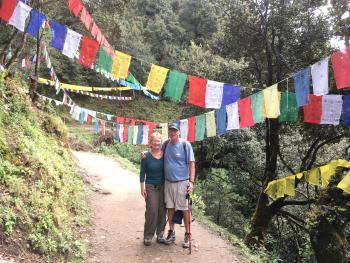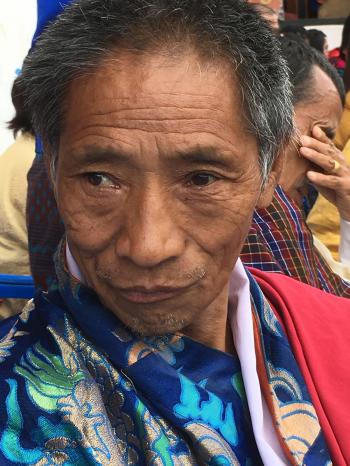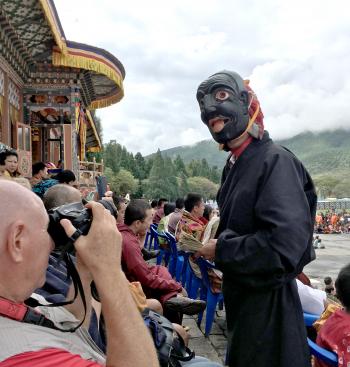A soul-enriching visit to Bhutan
This article appears on page 46 of the April 2017 issue.
Life is a compilation of experiences, and mine was enriched by the Bhutan odyssey that my husband, Ted, and I took in October 2016. In this tiny country nestled under the Himalayas between India and China, we found pristine natural beauty, ancient Buddhist monasteries and a guileless culture.
We arrived via a Drukair flight piloted by one of the few pilots from one of the few airlines approved for landing. The thrill of snaking into the Paro Valley between mountains stretching 18,000 feet high was unhindered by our fear. How novel to be able to peer into mountain homes from the plane.
Flights are canceled if there are dangerous winds, but our landing was a gentle drift to earth.
We disembarked to gaze 360 degrees at the mountains and sky. We had arrived in Bhutan, a whole other world.
Making plans
For Western travelers to Bhutan, traveling with a Bhutanese-affiliated tour company is required. The company will be responsible for visas and arranging all flights, hotels and in-country transportation. They will also be helpful in dealing with the inevitable innumerable questions.
We congratulated ourselves for selecting a Bhutanese company with US offices, Wind Horse Tours (Minneapolis, MN; 888/834-6773, www.windhorsetours.com). Wind Horse keeps tours small and proved helpful and pleasant on every contact.
Meeting us at the terminal, our energetic guide, Sonam, and valiant driver, Donghi, became immediately indispensable.
The fully inclusive 9-day tour, which included round-trip air from Bangkok, cost $2,730 per person, based on the full complement of nine travelers.
We chose the October 2016 festival tour. Advance reading and our guide’s presentation partially prepared us, but at each venue we were overwhelmed by color, music and pomp. The several-day religious events of dance and blessings were attended by family groups who’d walked miles over mountain paths and roads in their finest kira (women) and gho (men) carrying babies on their backs.
To our surprise, we Western visitors were treated royally and given the best seats to enjoy the entertainment, which included deep-throated long horns, cymbals, athletic dancers and salacious clowns who roamed the crowds seeking tips and laughter. We capitulated with US dollar bills, which were quickly grabbed and applauded.
Mountain landscapes
Throughout our tour, the value of having Sonam as our guide was reinforced daily. We were touched when he arranged a local-flavor dinner away from the bland hotel buffets, and he enriched our experience with colorful stories of his life and his family, who lived in a remote area in the east.
Also highly appreciated was Donghi’s driving prowess as he transported us over narrow, poorly maintained, mountain-hugging roads with countless switchbacks while circumnavigating rock slides, van-swallowing potholes, meandering cows, sleeping dogs and even brave pedestrians.
We finished one very long and, frankly, frightening drive, traveling in one day round trip from Punakha over the Black Mountains to arrive at 10,000 feet in the small village of Gangtey at the edge of Jigme Singye Wangchuck National Park.
We were all aware of the dangers, but, danger aside, that trip was our favorite for the chance it gave us to enjoy the remote beauty of the towering rhododendrons and pines and the encounters with a herd of grazing yaks and a fleeting family of wild boar, all from the van.
While there, several of us ventured on a muddy hike through the Phobjikha Valley, the winter home of the black-necked cranes that summer in Tibet.
Another notable hike began as we crossed a suspension bridge on foot, well protected by dozens of weather-worn prayer flags, and continued through rice fields ready for harvest, before climbing to the Khamsum Yuley Namgyal Chorten. At the top, we delighted in the blue skies above the distant Himalayas, the progressively lower green-gray mountains giving way to round hills and, eventually, valleys wearing saffron-colored rice-field cloaks cut by a twisting river.
Personal reflection
At dawn on October 10th, I wrote, “The morning is drizzly and cold, a day for layered clothing. I relish the view from our hotel room to the valley below where two rivers, the Pho and the Mo, converge to embrace the impressive Pungthang Dechen Phodrang Dzong. Four mountains kneel like monsters in the distant mist…. The dogs stop barking as the sky lightens. Chanting reaches my ears.”
While the hike to Tiger’s Nest (Paro Taktsang) on our last day was long, we found the steepest parts safe, with good steps and guardrails. We met people in their eighth decade of life who allowed themselves ample time, giving their packs to their younger companions.
We carried prayer flags for the monk’s blessing. At the monastery, I was filled with a sense of accomplishment and peace.
Tips to travelers
Travelers to Bhutan should research in advance the facts of the country’s population, religion, government, history, food, climate and culture using the myriad websites and publications that are available, but here are my hints if you’re planning a visit.
• Exchange $200 for the local currency, ngultrum, in small bills, at the airport, as ATMs can be problematic. You can use a major credit card at hotels to cover incidental charges.
• Paro is filled with souvenir and craft shops. Look around when you arrive, but buy on your departure day. Less-expensive souvenirs include prayer flags, scarves, purses, cards and key chains. Western-type items probably came from India.
• Pack good walking and hiking footwear and a light backpack. There is so much to see on even short walks through rice fields or to a hillside monastery. Plan on encountering lots of mud.
• The body below the neck, except for hands, must be covered before entering any monastery. Zip-off hiking pants are a wise choice.
• A small umbrella may be invaluable not only for possible drizzle but as a sun parasol.
• Having hotel laundry service helps reduce the amount of luggage needed. Allow 24 hours to get laundered clothing back. We found no need to pack a skirt or sport coat. Mornings may be cool, but when the sun comes out or as you hike, you will get quite warm, so dress in layers.
• If at all physically possible, do climb to Tiger’s Nest, even if you have to do so slowly. Wooden poles can be purchased cheaply at the base of the hill and can be returned before you leave.
• Drink only bottled water — lots of it — and use it when cleaning your teeth. The tour company stocked it on our van.
• Our hotels were selected by the tour company. All had free, though spotty, Wi-Fi and were clean, comfortable and beautifully situated on mountainsides, except in Thimphu, where we were downtown. The front desk employees all spoke English.
• Hotel food was buffet — bland but adequate — with rice and vegetables, plus bread only at breakfast. Chicken and fish were cut into pieces still containing bones, so beware. There were no desserts, just fruit.
Be bold in trying local foods, such as hemadatsi, or chili with cheese. Suja, or butter tea, is an acquired taste. We liked the local beer and wine.
• Pack antidiarrheal medication, even azithromycin (requires prescription) for severe problems, as well as other OTC medication. We took altitude-sickness medication, but not everyone did. One woman did develop a headache.
• Some toilets were Asian-style squat toilets, basically holes in the ground. Always carry toilet paper, damp wipes and hand sanitizer.
• Dogs were everywhere and barked all night. Our hotels were a bit removed from the village, but we could still hear the dogs. Pack earplugs. Dogs are not personal pets, but they did appear well fed and mostly healthy, though they were semiferal.
• Expect to spend many hours in a van. Enjoy the views, the fantastic Bhutanese architecture, the handsome people and the stunning flora. Overlook the roadside trash.
• Phalluses are revered as symbols of fertility and virility. They are painted on walls, carved in wood and available as souvenirs of various types, from table models to key chains.
• Tip your guide and driver generously.
Not only would I love to return to Bhutan, I do so, frequently, in my dreams.



